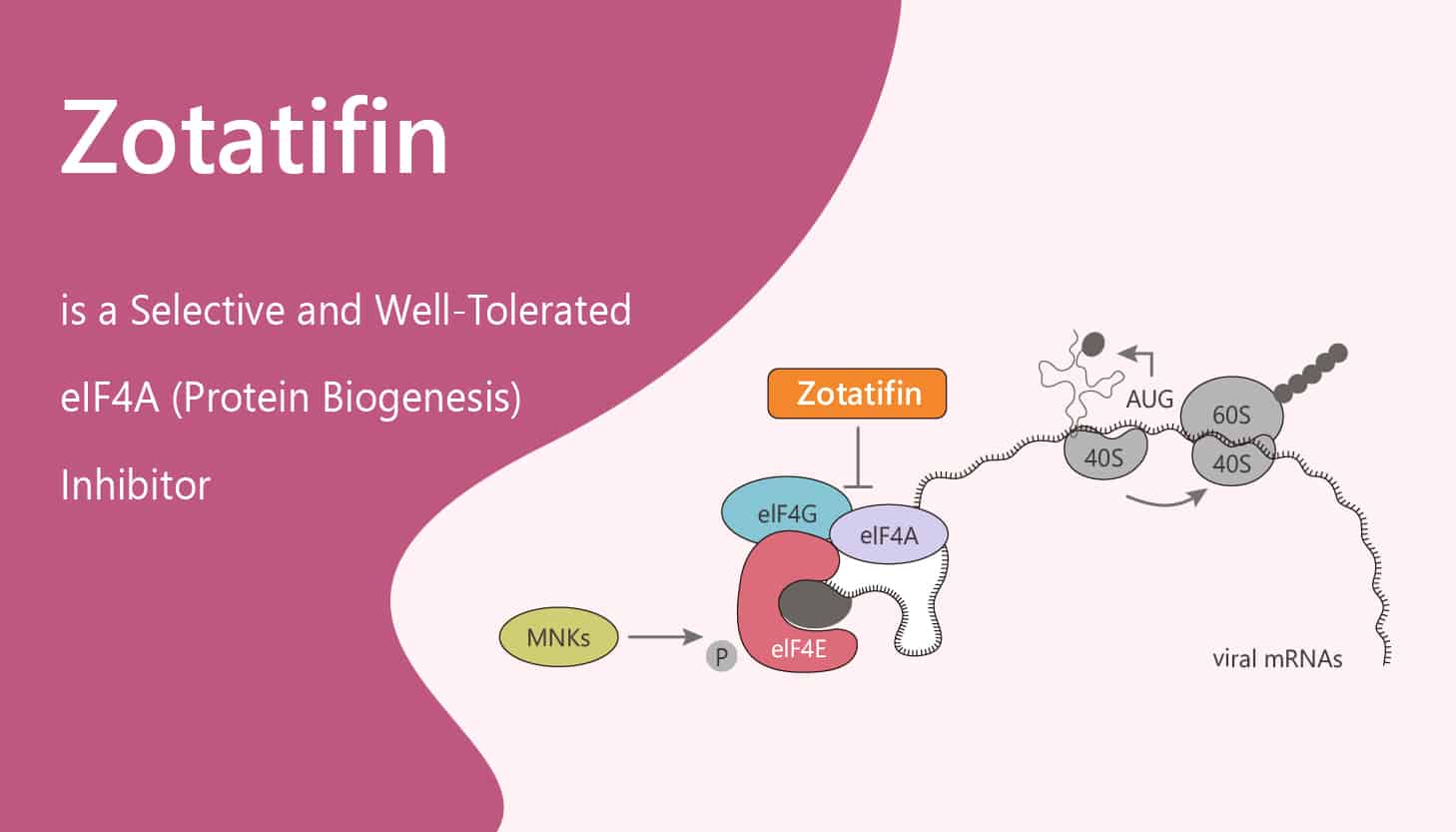In this article, we will introduce a potent, selective, and well-tolerated eIF4A inhibitor, Zotatifin. It promotes eIF4A binding to specific mRNA sequences with recognition motifs in the 5’-UTRs (IC50=2 nM).
Zotatifin is able to induce the formation of a stable ternary complex [eIF4A-RNA-eFT226]. Additionally, it increases the residence time for eIF4A1 binds to an AGAGAG RNA surface. When at the eFT226 presence or absence condition, the Kd values are 0.021 μM and 8.0 μM, respectively.
Firstly, in an MDA-MB-231 cell line with different 5’-UTRs-containing sequences, the IC50 range values are from 1.5 nM to 217.5 nM. Besides, in MDA-MB-231 tumor cells, Zotatifin inhibits tumor cell growth as a dose-dependent manner. It shows a potent anti-proliferative activity (GI50<15 nM). However, eIF4A1 F163L mutation rescues eFT226 anti-proliferative activity.
Not only MDA-MB-231 tumor cells. Zotatifin but also inhibits MD8, SU-DHL-2, HBL1, Pfeiffer, SU-DHL-6, SU-DHL-10, VAL, Carnaval, U2973, Ramos, Jeko1, and Mino cells as well. The GI50 values are 4.1 nM, 3 nM, 5.6 nM, 3.7 nM, 5.3 nM, 7.3 nM, 6.6 nM, 4.4 nM, 4.2 nM, 4.6 nM, 7.9 nM and 11.2 nM, respectively.
Zotatifin exhibits strong anti-viral activity.

It effectively reduces viral infectivity by inhibiting SARS-CoV-2 NP protein biogenesis (IC90=37 nM). The anti-viral activity of Zotatifin is demonstrated by various assays: such as TCID50 assay, Plaque assay, NP-staining assay, et al. Zotatifin 1 or 2 hours pre-treatment before virus isolates) decreases the detection of the viral NP protein in Vero E6 cells infected with SARS-CoV-2 isolates.
Lastly, In the B-cell lymphoma xenograft model, Zotatifin at 0.001 mg/kg-1 mg/kg inhibits the growth of B-cell lymphoma xenografts. And it is well-tolerated against B-cell lymphoma xenograft models.
In TMD8 xenograft-bearing, HBL1 xenograft-bearing, Pfeiffer xenograft-bearing, SU-DHL-6 xenograft-bearing, and Ramos-bearing animals’tumor. Zotatifin decreases these tumors’ growth as percentage of 97%, 87%, 70%, 83%, 37% and 75%, respectively.
In conclusion, as a potent eIF4A inhibitor. Zotatifin promotes eIF4A binding to specific mRNA sequences and interferes with the assembly of the eIF4F initiation complex. It results in translational regulation of oncogenic protein decrease MYC, CCND3, BCL2, and MCL1 protein expression. Additionally, Zotatifin exhibits antiviral activity and has the potential for the study of COVID-19.
Reference:
[1]. Peggy A. Thompson, et al. Preclinical Evaluation of eFT226, a Novel, Potent, and Selective eIF4A Inhibitor with Anti-tumor Activity in B-cell Malignancies.
[2]. Gordon DE, et al.Nature. 2020 Apr 30.